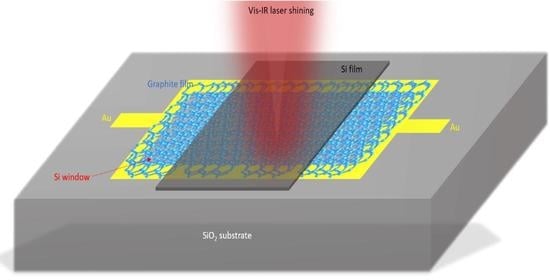Photodetection Tuning with High Absorptivity Using Stacked 2D Heterostructure Films
Abstract
1. Introduction
2. Materials, Devices, and Methods
3. Results and Discussion
4. Conclusions
Supplementary Materials
Author Contributions
Funding
Institutional Review Board Statement
Informed Consent Statement
Data Availability Statement
Conflicts of Interest
References
- Rogalski, A.; Kopytko, M.; Martyniuk, P. 2D material infrared and terahertz detectors: Status and outlook. Opto-Electron. Rev. 2020, 28, 107–154. [Google Scholar]
- Koppens, F.H.L.; Mueller, T.; Avouris, P.; Ferrari, A.C.; Vitiello, M.S.; Polini, M. Photodetectors based on graphene, other two-dimensional materials and hybrid systems. Nat. Nanotechnol. 2014, 9, 780–793. [Google Scholar] [CrossRef] [PubMed]
- Furchi, M.; Urich, A.; Pospischil, A.; Lilley, G.; Unterrainer, K.; Detz, H.; Klang, P.; Andrews, A.M.; Schrenk, W.; Strasser, G.; et al. Microcavity-integrated graphene photodetector. Nano Lett. 2012, 12, 2773–2777. [Google Scholar] [CrossRef]
- Konstantatos, G.; Badioli, M.; Gaudreau, L.; Osmond, J.; Bernechea, M.; De Arquer, F.P.G.; Gatti, F.; Koppens, F.H.L. Hybrid graphene-quantum dot phototransistors with ultrahigh gain. Nat. Nanotechnol. 2012, 7, 363–368. [Google Scholar] [CrossRef]
- Echtermeyer, T.J.; Britnell, L.; Jasnos, P.K.; Lombardo, A.; Gorbachev, R.V.; Grigorenko, A.N.; Geim, A.K.; Ferrari, A.C.; Novoselov, K.S. Strong plasmonic enhancement of photovoltage in graphene. Nat. Commun. 2011, 2, 458. [Google Scholar] [CrossRef] [PubMed]
- Martyniuk, P.; Antoszewski, J.; Martyniuk, M.; Faraone, L.; Rogalski, A. New concepts in infrared photodetector designs. Appl. Phys. Rev. 2014, 1, 041102. [Google Scholar] [CrossRef]
- Xia, F.; Wang, H.; Xiao, D.; Dubey, M.; Ramasubramaniam, A. Two-dimensional material nanophotonics. Nat. Photonics 2014, 8, 899–907. [Google Scholar] [CrossRef]
- Castro Neto, A.H.; Guinea, F.; Peres, N.M.R.; Novoselov, K.S.; Geim, A.K. The electronic properties of graphene. Rev. Modern Phys. 2009, 81, 109–162. [Google Scholar] [CrossRef]
- Bonaccorso, F.; Sun, Z.; Hasan, T.; Ferrari, A.C. Graphene photonics and optoelectronics. Nat. Photonics 2010, 4, 611–622. [Google Scholar] [CrossRef]
- Nair, R.R.; Blake, P.; Grigorenko, A.N.; Novoselov, K.S.; Booth, T.J.; Stauber, T.; Peres, N.M.R.; Geim, A.K. Fine structure constant defines visual transparency of graphene. Science 2008, 320, 1308. [Google Scholar] [CrossRef]
- Massicotte, M.; Schmidt, P.; Vialla, F.; Watanabe, K.; Taniguchi, T.; Tielrooij, K.J.; Koppens, F.H.L. Photo-thermionic effect in vertical graphene heterostructures. Nat. Commun. 2016, 7, 12174. [Google Scholar] [CrossRef] [PubMed]
- Mihnev, M.T.; Tolsma, J.R.; Divin, C.J.; Sun, D.; Asgari, R.; Polini, M.; Berger, C.; De Heer, W.A.; MacDonald, A.H.; Norris, T.B. Electronic cooling via interlayer Coulomb coupling in multilayer epitaxial graphene. Nat. Commun. 2015, 6, 8105. [Google Scholar] [CrossRef] [PubMed]
- Henisch, H.K. Metal-semiconductor Schottky barrier junctions and their applications. Proc. IEEE 2008, 74, 1–386. [Google Scholar] [CrossRef]
- Di Bartolomeo, A. Graphene Schottky diodes: An experimental review of the rectifying graphene/semiconductor heterojunction. Phys. Rep. 2016, 606, 1–58. [Google Scholar] [CrossRef]
- Balandin, A.A. Low-frequency 1/f noise in graphene devices. Nat. Nanotechnol. 2013, 8, 549–555. [Google Scholar] [CrossRef]
- Liu, Y.; Guo, J.; Zhu, E.; Liao, L.; Lee, S.J.; Ding, M.; Shakir, I.; Gambin, V.; Huang, Y.; Duan, X. Approaching the Schottky-Mott limit in van der Waals metal-semiconductor. Nature 2018, 557, 696–700. [Google Scholar] [CrossRef] [PubMed]
- Liu, C.; Ma, W.; Chen, M.; Ren, W.; Sun, D. A vertical silicon-graphene-germanium transistor. Nat. Commun. 2019, 10, 4873. [Google Scholar] [CrossRef]
- Yu, W.J.; Liu, Y.; Zhou, H.; Yin, A.; Li, Z.; Huang, Y.; Duan, X. Highly efficient gate-tunable photocurrent generation in vertical heterostructures of layered materials. Nat. Nanotechnol. 2013, 8, 952–958. [Google Scholar] [CrossRef]
- Xia, F.; Mueller, T.; Lin, Y.M.; Valdes-Garcia, A.; Avouris, P. Ultrafast graphene photodetector. Nat. Nanotechnol. 2009, 4, 839–843. [Google Scholar] [CrossRef]
- Allain, A.; Kang, J.; Banerjee, K.; Kis, A. Electrical contacts to two-dimensional semiconductors. Nat. Mater. 2015, 14, 1195–1205. [Google Scholar] [CrossRef]
- Novoselov, K.S.; Geim, A.K.; Morozov, S.V.; Jiang, D.E.; Zhang, Y.; Dubonos, S.V.; Grigorieva, I.V.; Firsov, A.A. Electric Field Effect in Atomically Thin Carbon Films. Science 2004, 306, 666–669. [Google Scholar] [CrossRef] [PubMed]
- Novoselov, K.S.; Fal’Ko, V.I.; Colombo, L.; Gellert, P.R.; Schwab, M.G.; Kim, K. A roadmap for graphene. Nature 2012, 490, 192–200. [Google Scholar] [CrossRef]
- Pham, V.P.; Kim, K.N.; Jeon, M.H.; Kim, K.S.; Yeom, G.Y. Cyclic chlorine trap-doping for transparent, conductive, thermally stable and damage-free graphene. Nanoscale 2014, 6, 15301–15308. [Google Scholar] [CrossRef] [PubMed]
- Kim, K.N.; Pham, V.P.; Yeom, G.Y. Chlorine Radical Doping of a Few Layer Graphene with Low Damage. ECS J. Solid State Sci. Technol. 2015, 4, N5095. [Google Scholar] [CrossRef][Green Version]
- Pham, V.P.; Kim, D.S.; Kim, K.S.; Park, J.W.; Yang, K.C.; Lee, S.H.; Yeom, G.Y.; Kim, K.N. Low energy BCl3 plasma doping of few-layer graphene. Sci. Adv. Mater. 2016, 8, 884–890. [Google Scholar] [CrossRef]
- Min-Dianey, K.A.A.; Le, T.K.; Qadir, A.; M’bouana, N.L.P.; Malik, M.; Kim, S.W.; Choi, J.R.; Pham, P.V. The ripple effect of graphite nanofilm on stretchable polydimethylsiloxane for optical sensing. Nanomaterials 2021, 11, 2934. [Google Scholar] [CrossRef]
- Min-Dianey, K.A.A.; Le, T.K.; Choi, J.R.; Pham, P. V Advanced Optical Detection through the Use of a Deformably Transferred Nanofilm. Nanomaterials 2021, 11, 816. [Google Scholar] [CrossRef]
- Pham, P.; Goel, P.; Kumar, S.; Yadav, K. 21st Century Surface Science a Handbook; IntechOpen: London, UK, 2020; pp. 1–280. [Google Scholar] [CrossRef]
- Pham, V.P. Direct Growth of Graphene on Flexible Substrates toward Flexible Electronics: A Promising Perspective; IntechOpen: London, UK, 2018; pp. 1–111. [Google Scholar] [CrossRef][Green Version]
- Pham, P.V. Hexagon Flower Quantum Dot-like Cu Pattern Formation during Low-Pressure Chemical Vapor Deposited Graphene Growth on a Liquid Cu/W Substrate. ACS Omega 2018, 3, 8036–8041. [Google Scholar] [CrossRef]
- Pham, P. A Library of Doped-Graphene Images via Transmission Electron Microscopy. C 2018, 4, 34. [Google Scholar] [CrossRef]
- Pham, P.V. Cleaning of graphene surfaces by low-pressure air plasma. R. Soc. Open Sci. 2018, 5, 172395. [Google Scholar] [CrossRef]
- Dean, C.R.; Young, A.F.; Meric, I.; Lee, C.; Wang, L.; Sorgenfrei, S.; Watanabe, K.; Taniguchi, T.; Kim, P.; Shepard, K.L.; et al. Boron nitride substrates for high-quality graphene electronics. Nat. Nanotechnol. 2010, 5, 722–726. [Google Scholar] [CrossRef] [PubMed]
- Pham, V.P.; Jang, H.S.; Whang, D.; Choi, J.Y. Direct growth of graphene on rigid and flexible substrates: Progress, applications, and challenges. Chem. Soc. Rev. 2017, 46, 6276–6300. [Google Scholar] [CrossRef] [PubMed]
- Pham, V.P.; Nguyen, M.T.; Park, J.W.; Kwak, S.S.; Nguyen, D.H.T.; Mun, M.K.; Phan, H.D.; Kim, D.S.; Kim, K.H.; Lee, N.E.; et al. Chlorine-trapped CVD bilayer graphene for resistive pressure sensor with high detection limit and high sensitivity. 2D Mater. 2017, 4, 025049. [Google Scholar] [CrossRef]
- Pham, V.P.; Mishra, A.; Young Yeom, G. The enhancement of Hall mobility and conductivity of CVD graphene through radical doping and vacuum annealing. RSC Adv. 2017, 7, 16104–16108. [Google Scholar] [CrossRef]
- Pham, V.P.; Kim, K.H.; Jeon, M.H.; Lee, S.H.; Kim, K.N.; Yeom, G.Y. Low damage pre-doping on CVD graphene/Cu using a chlorine inductively coupled plasma. Carbon 2015, 95, 664–671. [Google Scholar] [CrossRef]
- Sone, J.; Murakami, M.; Tatami, A. Fundamental study for a graphite-based microelectromechanical system. Micromachines 2018, 9, 64. [Google Scholar] [CrossRef]
- Shioyama, H. Interactions of two chemical species in the interlayer spacing of graphite. Synth. Met. 2000, 114, 1–15. [Google Scholar] [CrossRef]
- Amedome Min-Dianey, K.A.; Zhang, H.C.; M’Bouana, N.L.P.; Kougblenou, K.; Xia, X. Limitation of optical properties through porous silicon photonic crystals influenced by porosity and lattice dynamic. Opt. Mater. 2018, 75, 150–165. [Google Scholar] [CrossRef]
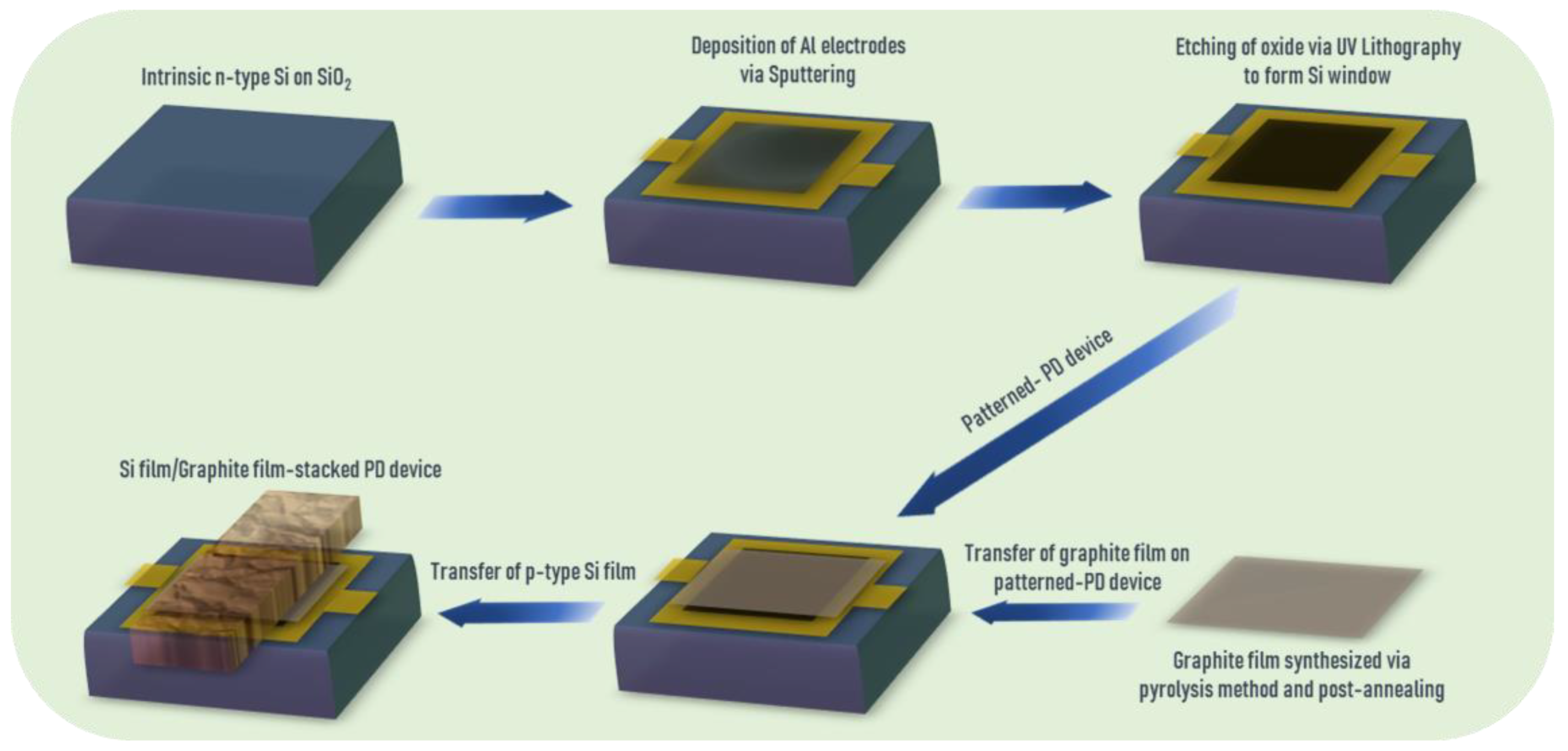
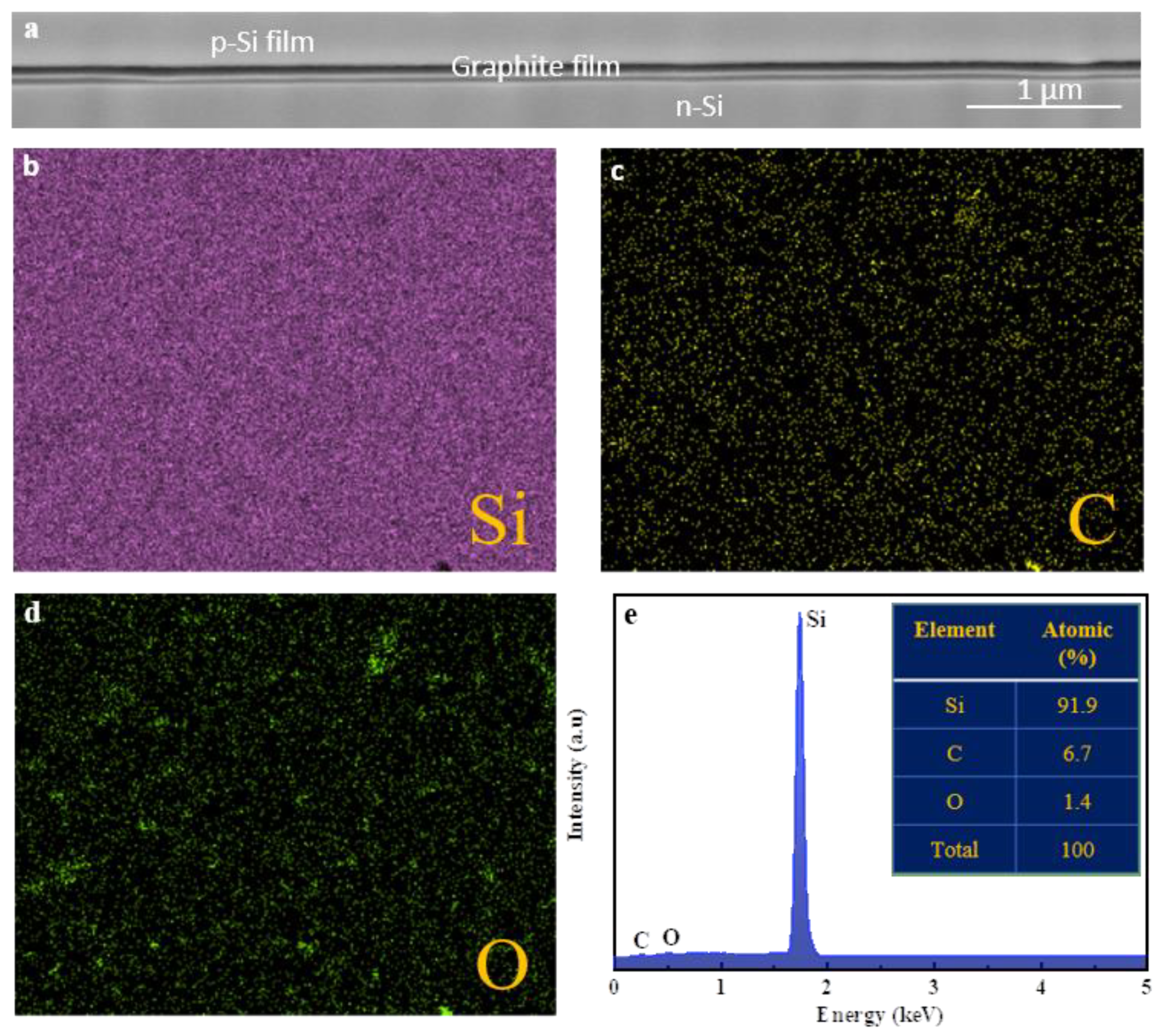
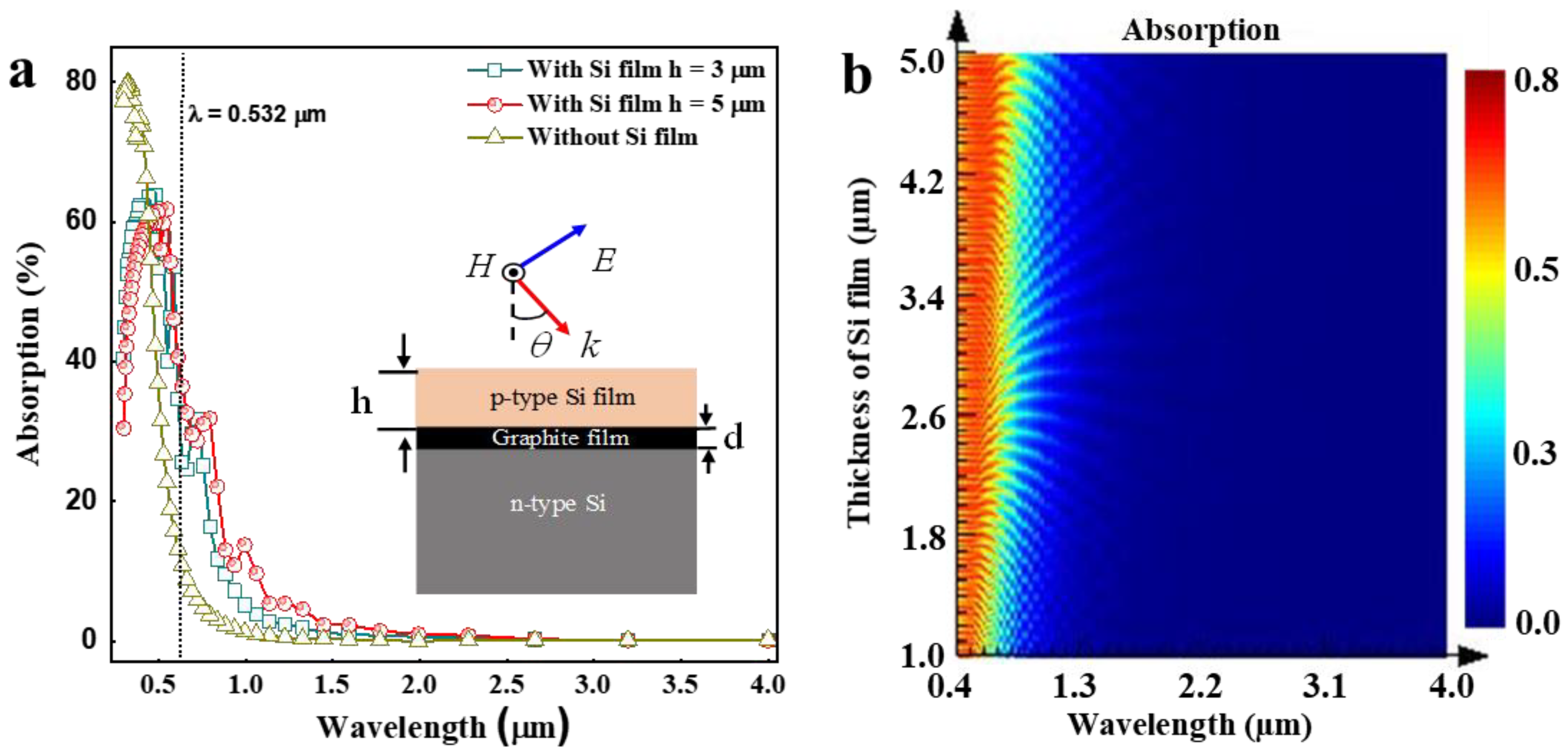

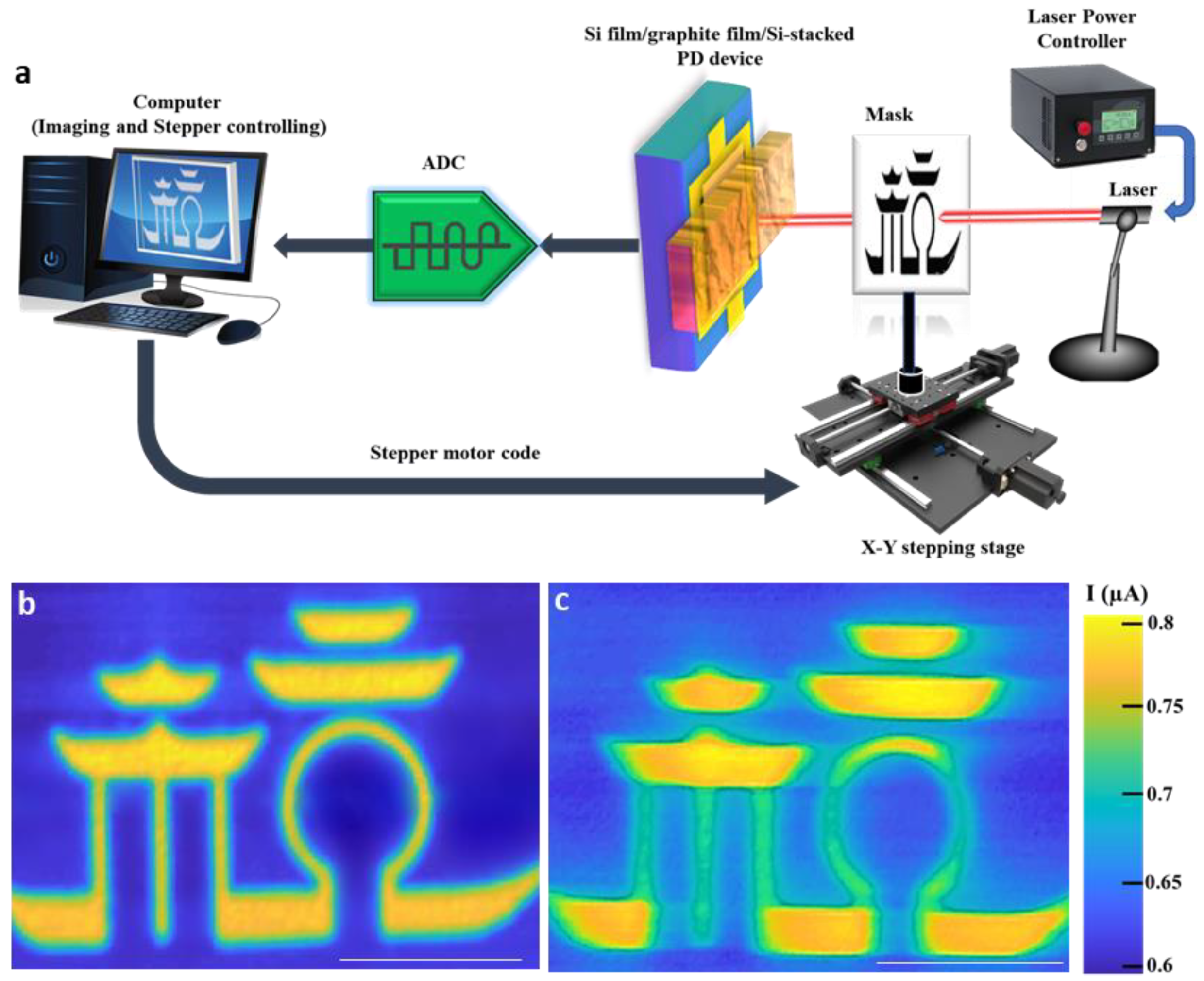
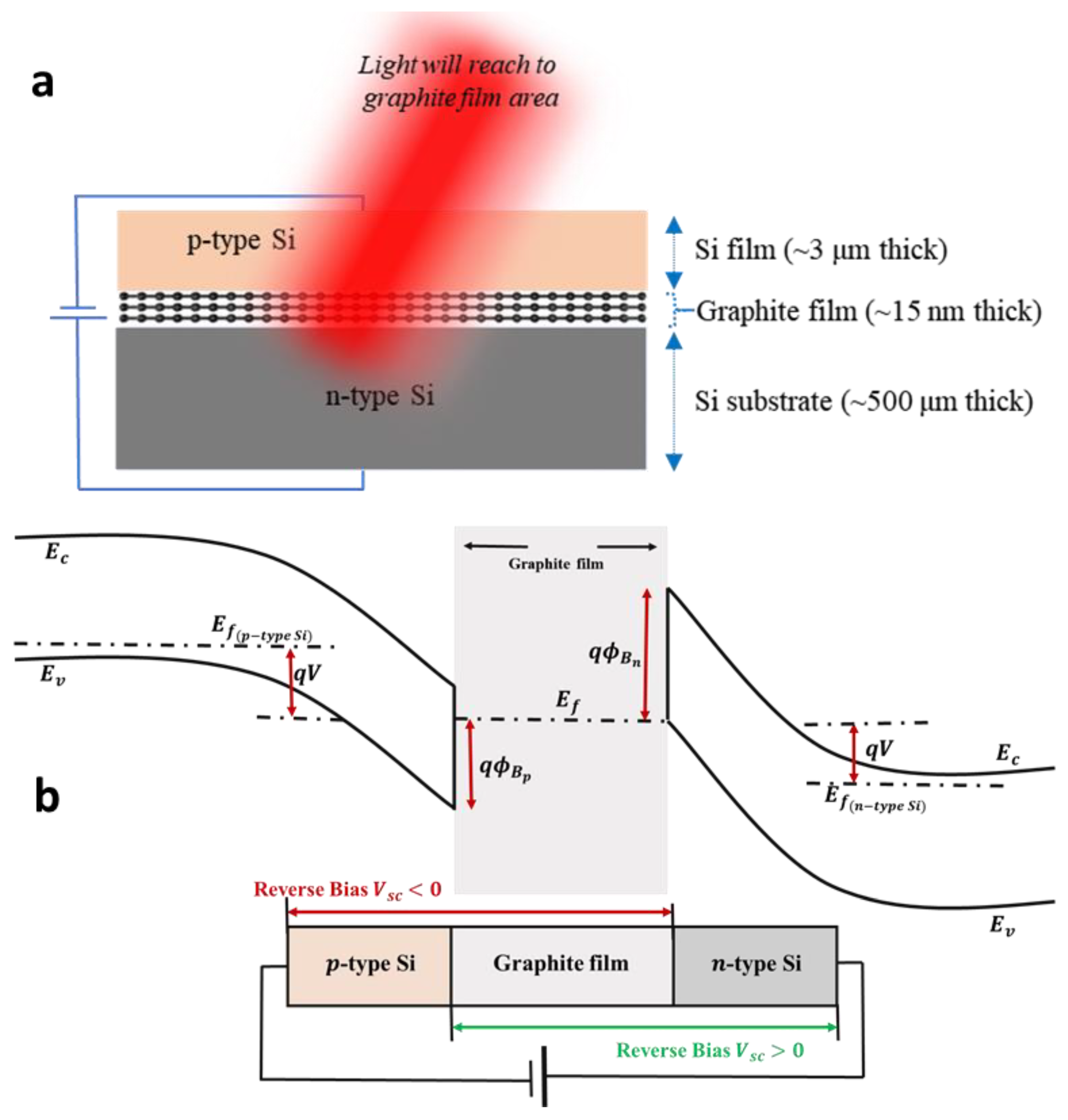
| R | NEP | D* | Rise/Fall Time | EQE | |
|---|---|---|---|---|---|
| Si film/graphite film/Si-stacked PD device | 100 mA/W | 14.53 × 10−10 W/(Hz)1/2 | 3.44 × 106 Jones | 38 μs/1 μs | 0.2 |
Publisher’s Note: MDPI stays neutral with regard to jurisdictional claims in published maps and institutional affiliations. |
© 2022 by the authors. Licensee MDPI, Basel, Switzerland. This article is an open access article distributed under the terms and conditions of the Creative Commons Attribution (CC BY) license (https://creativecommons.org/licenses/by/4.0/).
Share and Cite
Farooq, U.; Min-Dianey, K.A.A.; Rajagopalan, P.; Malik, M.; Kongnine, D.M.; Choi, J.R.; Pham, P.V. Photodetection Tuning with High Absorptivity Using Stacked 2D Heterostructure Films. Nanomaterials 2022, 12, 712. https://doi.org/10.3390/nano12040712
Farooq U, Min-Dianey KAA, Rajagopalan P, Malik M, Kongnine DM, Choi JR, Pham PV. Photodetection Tuning with High Absorptivity Using Stacked 2D Heterostructure Films. Nanomaterials. 2022; 12(4):712. https://doi.org/10.3390/nano12040712
Chicago/Turabian StyleFarooq, Umar, Kossi A. A. Min-Dianey, Pandey Rajagopalan, Muhammad Malik, Damgou Mani Kongnine, Jeong Ryeol Choi, and Phuong V. Pham. 2022. "Photodetection Tuning with High Absorptivity Using Stacked 2D Heterostructure Films" Nanomaterials 12, no. 4: 712. https://doi.org/10.3390/nano12040712
APA StyleFarooq, U., Min-Dianey, K. A. A., Rajagopalan, P., Malik, M., Kongnine, D. M., Choi, J. R., & Pham, P. V. (2022). Photodetection Tuning with High Absorptivity Using Stacked 2D Heterostructure Films. Nanomaterials, 12(4), 712. https://doi.org/10.3390/nano12040712







